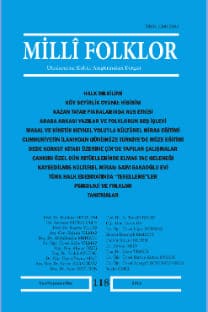ULUSLARARASI HUKUK AÇISINDAN SOMUT OLMAYAN KÜLTÜREL MİRASIN KORUNMASI REJİMİ
Regime for the Safeguarding of the Intangible Cultural Heritage: From International Law Perspective
___
- Aikawa, Noriko. “An Historical Overview of the Preparation of the UNESCO International Convention for the Safeguarding of the In- tangible Cultural Heritage”. Museum Inter- national 56.1-2 (2004): 137-149.
- Alpaslan, İrem. “Uluslararası Hukukta Kültürel Mirasın Korunması ve UNESCO Örneği”. Yayımlanmamış yüksek lisans tezi. Ankara: Ankara Üniversitesi, 2018.
- Basat, Ezgi Metin. “Somut ve Somut Olmayan Kültürel Mirası Birlikte Koruyabilmek”. Millî Folklor 25.100 (Kış 2013): 61-71.
- Bertacchini, Enrico, Claudia Liuzza ve Lynn Meskell. “Shifting the Balance of Power in the UNESCO World Heritage Committee: an Empirical Assessment”. International Jour- nal of Cultural Policy 23.3 (2017): 331-351.
- Bodansky, Daniel. The Art and Craft of Interna- tional Environmental Law. Harvard Univer- sity Press, Massachusetts, 2010.
- Bortolotto, Chiara. “From Objects to Processes: UNESCO’s ‘Intangible Cultural Heritage’”. Journal of Museum Ethnography, 19 (2007): 21-33.
- Breitmeier, Helmut, Oran R. Young and Michael Zürn. Analyzing International Environmen- tal Regimes: from Case Study to Database, MIT Press, Cambridge, 2006.
- Brown, Michael F. “Heritage Trouble: Recent Work on the Protection of Intangible Cultu- ral Property”. International Journal of Cul- tural Property 12.1 (2005): 40-61.
- Caust, Josephine ve Marilena Vecco. “Is UNES- CO World Heritage Recognition a Blessing or Burden? Evidence from Developing Asian Countries”. Journal of Cultural Heritage 27 (2017): 1-9.
- D’Eramo, Marco. ‘‘UNESCOCIDE’’. New Left Re- view 88 (2014):47-53.
- Francioni, Francesco. “Beyond State Sovere- ignty: the Protection of Cultural Heritage as a Shared Interest of Humanity”. The Michi- gan Journal of International Law 25 (2003): 1209-1228.
- Gürçayır, Selcan. “Somut Olmayan Kültürel Mi- rasın Korunması Sözleşmesi Üzerine Eleş- tirel Bir Okuma”. Millî Folklor 23.92 (Kış 2011): 5-12.
- Haas, Peter M. “Epistemic Communities and the Dynamics of International Environmental Co-Operation” Regime Theory and Interna- tional Relations (ed. Volker Rittberger) Cla- rendon Press, New York, 1993:168-201.
- Kurin, Richard. “Safeguarding Intangible Cultu- ral Heritage in the 2003 UNESCO Conventi- on: a Critical Appraisal”. Museum Internati- onal 56.1-2 (2004): 66-77.
- Lixinski, Lucas. “International Cultural Herita- ge Regimes, International Law, and the Po- litics of Expertise”. International Journal of Cultural Property 20.4 (2013a): 407-429.
- ————. “Luci e Ombre: The Bright and Dark Sides of International Heritage Law”. The Italian Yearbook of International Law Onli- ne 22.1 (2013b): 133-153.
- ————. “Selecting Heritage: The Interplay of Art, Politics and Identity”. European Jour- nal of International Law 22.1 (2011): 81-100. Meskell, Lynn. “UNESCO’s World Heritage Con- vention at 40: Challenging the Economic and Political Order of International Heritage Conservation”. Current Anthropology 54.4 (2013): 483-494.
- Mitchell, Ronald B. “Institutional Aspects of Implementation, Compliance, and Effecti- veness” International Relations and Global Climate Change (Eds. Urs Luterbacher ve Detlef F. Spinz) MIT Press, Massachusetts, 2001: 221-244.
- Mitchell, Ronald B. “Regime Design Matters: In- tentional Oil Pollution and Treaty Complian- ce”. International Organization 48.3 (1994): 425-458.
- Oğuz, Öcal. “SOKÜM’ün Korunması Sözleşmesi- ne Giden Yolda 1989 Tavsiye Kararı”, Millî Folklor 20.80 (Kış 2008): 26-32.
- ————. “Somut Olmayan Kültürel Miras ve Kültürel İfade Çeşitliliği”. Millî Folklor 82 (Yaz 2009): 6-12.
- ————. “Terim Olarak Somut Olmayan Kültü- rel Miras”. Millî Folklor 25.100 (Kış 2013): 5-13.
- Ölçer Özünel, Evrim. ““İnsanlar, Gezegen ve Re- fah İçin Bir Eylem Planı’’: Somut Olmayan Kültürel Miras ve 2030 Sürdürülebilir Kal- kınma Hedeflerine Eleştirel Yaklaşım”. Millî Folklor 116 (Kış 2017a): 18-32.
- ————.“Somut Olmayan Kültürel Mirasın Ka- ranlık Yüzleri: Turistifikasyon, Bağlamın- dan Koparma, Millileştirme, Müzeifikasyon, Otantifikasyon Ve Aşırı Ticarileşme”, Kül- türel Mirasın Korunması Uluslararası Bur- sa Sempozyumu, 19-20 Ekim 2017, Bursa, 2017b): 349-366.
- UNESCO. 2018a “Member States” 01 Kasım 2018.
- ————. 2018b “States of Parties” 01 Kasım 2018.
-
- ————. “Operational Directives for the Imple- mentation of the Convention for the Safegu- arding of the Intangible Heritage” 28 Kasım 2018.
- ————. 2018c “Accredited NGOs” 29 Kasım 2018. < https:// ich.unesco.org/en/ accredited- ngos-00331>
- Weiss, Edith Brown. “Strengthening National Compliance with International Environmen- tal Agreements”. Environmental Policy and Law 27 (1997): 297
- ISSN: 1300-3984
- Yayın Aralığı: 4
- Başlangıç: 1989
- Yayıncı: Geleneksel Yayıncılık Eğitim San. Tic. Ltd. Şti.
TÜRKÇE VE YUNANCA KAYNAKLARDA KARAKONCOLOS / KALİKANCAROS İNANCI
UNESCO’nun Somut Olmayan Kültürel Miras Listelerine Niceliksel Bir Yaklaşım: Eleştiri ve Öneriler
UNESCO’NUN 1972 VE 2003 SÖZLEŞMELERİNİN TAVSİYE ORGANLARI: DENEYİMLER VE SORUNLAR
PINAR FEDAKAR, GONCA KUZAY DEMİR
UNESCO SOKÜM TEMSİLİ LİSTESİNDE TÜRKİYE’NİN ÇOK ULUSLU DOSYALARI
AHMET VEFİK PAŞA’NIN UYARLAMALARINDA HALK DİLİ KULLANIMI
SOMUT OLMAYAN KÜLTÜREL MİRASIN KORUNMASI SÖZLEŞMESİNDE TOPLULUK KATILIMININ ÇIKMAZLARI
